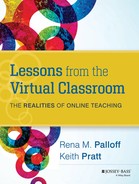Book Description
Rena Palloff and Keith Pratt, the most trusted online teaching experts, have completely updated and revised this classic to reflect changes in technology and advances in online teaching made in the last decade, in order to meet today's online learning challenges. The book continues to offer helpful suggestions for dealing with such critical issues as evaluating effective tools, working with online classroom dynamics, addressing the special needs of online students, making the transition to online teaching, and promoting the development of the learning community. Filled with numerous examples from actual online courses and insights from teachers and students, new topics include the open source movement, Web 2.0, Google groups, and topics for the K-12 sector.
Table of Contents
- Cover
- Series
- Title Page
- Copyright
- Figures, Table, and Exhibits
- Preface to the Second Edition: The Face of Online Learning Today
- The Authors
- Acknowledgments
- Part One: Rethinking Education for an Online World
- Chapter One: Online Learning in the Twenty-First Century
- Chapter Two: The Art of Online Teaching
- Lack of Preparation
- Who Should Teach Online?
- Training, Training, and More Training
- Using Mobile Technology in Faculty Training
- New Processes, New Relationships
- Online Pedagogy
- Keys to Success
- The Final Transition: Assessing and Evaluating Students and Ourselves
- Supporting Instructors to Make the Transition
- Chapter Three: Administrative Issues and Concerns
- Chapter Four: The Tools of Online Teaching
- Part Two: Teaching and Learning Online
- Chapter Five: Transforming Courses for the Online Classroom
- Chapter Six: Teaching Courses Developed by Others
- A Focus on Content
- Ability to Adjust the Course
- Examples of Customization
- When Customizing Is Not Possible
- Building Community into the Process
- Evaluating a Course Developed by Another
- Issues of Intellectual Property
- Courses with Rolling Admission
- Final Thoughts on Teaching a Course Developed by Another
- Chapter Seven: Working with the Virtual Student
- If We Build It, They Will Come
- The Successful Learner in the Online Classroom
- Addressing Different Learning Styles
- Recognizing and Working with Those Who Do Not Succeed
- The Role of the Learner in the Online Learning Process
- Maximizing the Potential of the Virtual Student
- Teaching Students to Learn in the Online Environment
- Respecting Student Intellectual Property
- Chapter Eight: Online Classroom Dynamics
- Chapter Nine: Lessons Learned in the Virtual Classroom
- Appendix A: Sample Training for Faculty
- Appendix B: Additional Resources
- References
- Index
